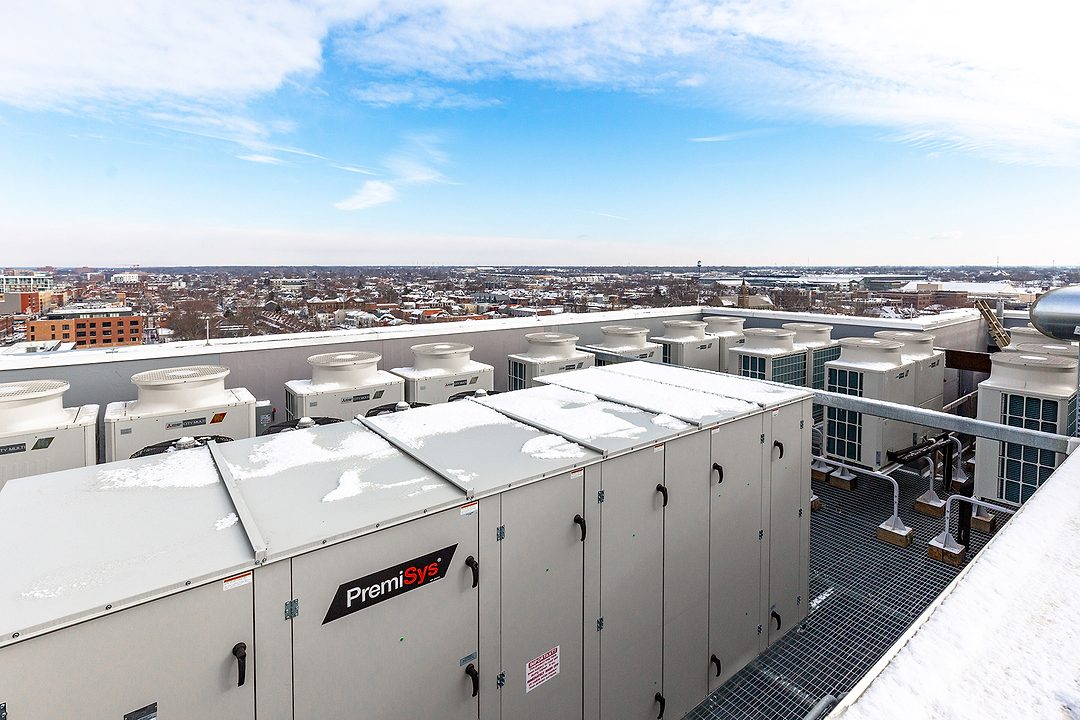Heat Pumps for a Better Tomorrow
The United States and other countries are taking steps to make heat pumps more accessible to average homeowners through financing.

I packed my things for a trip to the family cottage and cheerfully looked forward to breathing in the fresh backwoods air and paddling a canoe with family members. I’m hoping the weather holds. I’m writing this on the kind of day that makes you feel happy to be alive: blue skies with a few puffy clouds, crisp air and warm sunshine in late June. But I’m worried that by the time you read it a month from now, the world could seem cloudier.
America is getting hit with higher prices and may be facing a recession, the Ukraine war continues unpredictably, food and water shortages are growing, and climate change events are increasing.
President Joe Biden declared that heat pumps and solar panels are essential to national defense. The Department of Defense said that a clean energy economy could help avert threats to the water supply, food production and infrastructure, not to mention global warming and price shocks in volatile commodity markets, such as the fossil fuels that figure prominently in the Russia/Europe
confrontation.
The United States, Germany and many other countries are taking steps to increase the production of heat pumps and make them more accessible to average homeowners through grants and financing programs.
Late last year, heat pump maker Daikin was featured at a New York City event where Vice President Kamala Harris and Secretary of Energy Jennifer Granholm talked about HVAC industry partners working with the Department of Energy on something called a Cold Climate Heat Pump Technology Challenge. To an extent, this challenge has already been solved, but there are some caveats.
Daikin’s Aurora line and Mitsubishi’s Hyper-heating H2i line both maintain full heating capacity down to
5 F and can work down to -13 F. The Mitsubishi product has HSPF ratings for heating efficiency from 10.5 to 12, SEER ratings of 15 to 20, and coefficients of performance as high as 2.88 at 5 F. Fujitsu’s AOU variable-speed models produce 75% to 95% as much heat at 5 F as they do at 47 F, and are rated to work down to -10 F.
If you have read this column before, you likely have come across case examples of heat pumps in hot and cold places around North America. Read on to find more.
Still, if someone swaps out a big, oversized gas furnace for an air-source heat pump or mini-split in a drafty, uninsulated house with bad windows, they may feel cold in the winter, especially with the older heat pumps not equipped with variable speeds. Modern buildings are all about precise HVAC sizing and better envelopes.
Experienced engineers say that an oversized heat pump is actually worse than a slightly undersized one because the most comfortable and efficient use of a heat pump is when it’s constantly running at variable speeds, keeping warm air moving through a home. If it’s too large, it will start and stop more, waste energy, wear on the system, and create hot and cold zones.
In modern, super-insulated homes with double- or triple-pane windows, cold spots have not been a problem, which is why governments should couple heat pump financing programs with energy conservation retrofit programs.
The United Kingdom’s government started down this road, but then the insulation upgrade program it had introduced hit some bureaucratic speedbumps and also was more popular than expected. Its cost went up and the government canceled it. Then the Russia/Ukraine war broke out and the same government has since created incentives for heat pumps without building envelope upgrades. The program has met some resistance, likely due to factors already mentioned.
Hundreds of reports show that clean energy is as capable as the fossil-fuel systems it is replacing and can be deployed quickly and for less than the cost of not deploying it. It is cheaper to operate than old technology and offers other benefits you would expect from new digital technology.
Sometimes I think governments metaphorically make cloudy days even stormier. They are motivated by big oil political donations, which “cloud” their judgment. To avoid funding a war that could expand further in Europe, many countries made bold announcements about deploying more clean energy and ending reliance on Russian oil.
While some of this is indeed happening, governments are also increasing the use of liquified natural gas without properly crunching the numbers to determine whether it’s a wise course of action, a kneejerk reaction, or simply the next chapter in unconscionable slush money for their fossil-fuel friends.
Mixed-Use VRF Heat Pumps
For a 10-story, 150,000-square-foot building at 800 North High Street in Columbus, Ohio, engineers specified 215 tons of Mitsubishi-Trane Electric variable refrigerant flow (VRF) equipment. The mixed-use building includes a coworking space, two restaurants and Marriott’s new, modern hotel brand, Moxy. It was completed in 2019.
The contractors installed 90% of the mechanical systems for the building on a single platform located on the roof. Mitsubishi-Trane outdoor units run efficiently even when located close together. The space-saving meant that architects could add a rooftop hotel bar on the same level as the mechanical platform.
For heating and cooling delivery in the hospitality areas of the building, they used ducted units. In the electrical areas, they used wall-mounted units and ductless ceiling cassettes in the coworking space. The VRF system could supply them all and allowed designers to reduce penetrations from big duct openings to much smaller chases for the line sets.
The design specified 21 outdoor hyper-heat heat recovery units and did not add supplementary or auxiliary heat. Columbus has winter design temperatures near 0 F; the outdoor units are able to maintain the set point temperature even on a zero-degree day. The system’s heat recovery also helps provide a comfortable atmosphere while ensuring efficient energy usage. The system rejects heat to different areas rather than rejecting it outside, which would be more costly.
The system also saved money because VRF is flexible enough to add indoor units as spaces are leased, and local power utility grants were available, designed to incent the nation’s shift to low-carbon HVAC. It’s only fair to say that governments can sometimes get it right.
Heat Pump Retrofit
Some years back, West Hernando Middle School in Brooksville, Fla., was faced with replacing aging and outdated building systems to improve the learning environment for its students and faculty. It installed a Daikin split-system, 100% dedicated outdoor air system (DOAS) consisting of rooftop variable refrigerant volume (VRV) condensing units and indoor air-handling units.
In this case, the manufacturer worked closely with a local engineering firm and builder on upgrades to the building insulation and replacement of the electrical system.
The project spans seven buildings, each with a different footprint. Incorporating split-system DOAS equipment for each building retrofit provided conditioned fresh outdoor air to the indoor space at 70 F and 50% relative humidity.
A study from the National Center for Education Statistics concludes that nearly half of U.S. public schools reported issues with indoor air quality. The upgrade at West Hernando made it easy to manage building comfort, humidity and temperature while also keeping energy costs down. Students, teachers and administrators work and learn more productively when physical environments are comfortable.
VRV equipment was ideal for the retrofit because it met the district’s need for a highly energy-efficient solution. It also allowed for independent and simultaneous zone-based heating and cooling. For example, a southern-exposed classroom can provide cooling at the same time as a northern-exposed classroom provides heating, all from the same system.
Daikin built a web-based energy dashboard enabling the facility operations team to access and analyze data, and control the system from anywhere. At the beginning of each construction phase, energy monitors were installed one month prior to construction to accurately measure energy consumption of the old system. As each DOAS and VRV retrofit phase was completed, the energy monitors captured and calculated results — there was an average 40% reduction in energy use.
Measuring results supports school administrators who work with the district leadership and school board to establish returns on investment and, thus, design a cleaner, more comfortable, energy-efficient future for schools all over the district.
Air Quality, Smart Home, Easier Service
At this year’s AHR Expo, Dave Palazzolo, director of residential product marketing at Daikin, explained to me that the company’s new Aurora line paired inverters with reluctance DC motors to cut energy use by more than 50%. He said inverter technology allows the air handler to constantly monitor the environment and make frequent, small temperature adjustments by changing the motor speed without needing to turn the motor on and off.
It results in less energy usage, cost savings, better reliability, less noise and vibration, and tighter control around set points of temperature and humidity. “Most organizations are focused on energy savings to help with energy independence and reduced greenhouse gas emissions,” he said.
Palazzolo added that the manufacturer had made systems quieter, eliminated initial cold blasts and was moving toward one whole-home interface. “It will work better with smart home systems and help with data collection,” he noted. “For example, Daikin has 40 million Swing compressor products installed around the world, which leads to data pattern analysis and results in efficiencies when planning service calls. Sometimes you can do diagnostics without having to do a truck roll.
“An advantage with whole-home design is we can install a sensor in the ductwork to pick up the presence of volatile organic compounds (VOCs) in the house. If particle counts increase VOCs, the thermostat kicks on the vent blower. We’ve also launched a room temperature catalyst that neutralizes some VOCs.”
As governments worldwide shift to heat pumps, sales are zooming up. Companies such as Daikin and Mitsubishi with established global supply chains are poised to do well, presuming they don’t get crunched by recession, climate storms, oil wars and more pandemics.
HVAC Modeling Software
The Willdan NEO (Net Energy Optimizer) is a software-as-a-service energy modeling platform providing customized, real-time energy and financial ROI analysis in seconds. It helps engineers streamline whole-building planning for HVAC systems and energy conservation measures for commercial buildings. It supports product comparisons, existing building energy audits and new construction, from early design through
construction.
NEO uses default inputs from vetted industry standards (ASHRAE, COMNET, RS Means) to automate the modeling process. It supports 40-plus commercial building types (including mixed-use and multifamily) and more than 250 operational and capital improvement measures coupled with automated ASHRAE Standard 90.1 and IECC baselines.
It performs HVAC life-cycle cost analyses to help users make faster, more-informed HVAC decisions and rating analyses to empower users to evaluate the ROI of energy conservation measures when specifying, designing and maintaining higher-performing buildings.
NEO graphically reports results, generates downloadable input/simulation files, and creates CSV and MS Word documents detailing key model inputs and outputs. It is web-based, touch-friendly and requires no software installation. It won an innovation award at this year’s AHR Expo in Las Vegas.
So, whether you’re at the cottage, camping or staying home and curling up in a ball and fretting about the world out there, you now possess the tools to design clean, efficient systems and control them from anywhere. Tomorrow is a new day!





